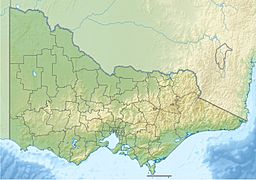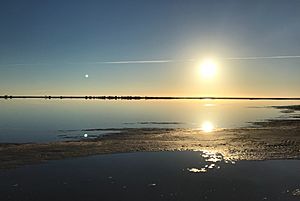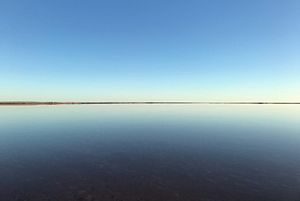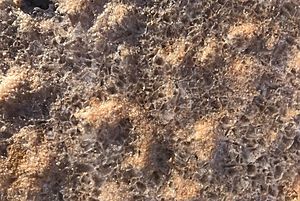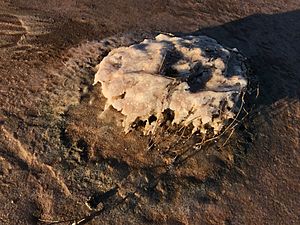Lake Tyrrell facts for kids
Quick facts for kids Lake Tyrrell |
|
|---|---|
| Location | Mallee district, Victoria |
| Coordinates | 35°20′38″S 142°50′00″E / 35.34389°S 142.83333°E |
| Type | Intermittent |
| Primary inflows | Tyrrell Creek |
| Basin countries | Australia |
| Surface area | 20,860 ha (51,500 acres) |
Lake Tyrrell is a very shallow, salty lake in north-west Victoria, Australia. It is a natural depression covered in a crust of salt. The name "Tyrrell" comes from a local Aboriginal word meaning 'sky'. The Boorong Aboriginal people, who lived here, were known for their interest in stars. They told many stories about the constellations in the night sky.
In recent years, Lake Tyrrell has become a very popular place for tourists. Many visitors, especially from China, come to see its unique beauty. It's a favorite spot for photographers and people who love social media. They take amazing pictures of the lake's surface, which looks like a giant mirror. This happens mostly in winter when water from underground and from the Avoca River system flows into the lake.
During dry times, the lake's surface becomes solid salt. This means you can actually walk out onto the lake! It's a truly unique experience.
Contents
About Lake Tyrrell: Size and Location
Lake Tyrrell is the biggest salt lake in Victoria. It covers an area of about 20,860 hectares. To give you an idea, that's like more than 20,000 football fields!
The lake is located about 6 kilometers north of a town called Sea Lake. It's also about 314 kilometers northwest of Melbourne, Victoria's capital city.
How Lake Tyrrell Was Formed
Most of the time, the lake is dry. But in winter, it usually has about 5 centimeters of water. Lake Tyrrell is very old. Scientists believe it formed when sand blocked the path of Tyrrell Creek. This creek is a branch of the Avoca River, which still feeds water into the lake.
The lake's saltiness comes from Evaporation. When the water evaporates, it leaves behind a layer of salt. This salt forms a crust on the lake bed. A company called Cheetham Salt, located in Sea Lake, actually harvests this salt.
Wildlife and Plants at the Lake
The area around Lake Tyrrell is home to many interesting animals. You might see Mallee reptiles, kangaroos, and emus. A small bird called the white-fronted chat also lives here. It likes to eat insects.
Thousands of seagulls come to the lake to breed. They build their nests on small islands in the water. The plants around the lake are mostly saltbush and samphire. These plants are special because they can grow in salty soil. They provide food and shelter for all the local wildlife.
To the east of the lake, there's a sand dune called a lunette. This area holds important Aboriginal artifacts and historical sites.
A Glimpse into Lake Tyrrell's Past
About 120,000 years ago, Lake Tyrrell was very different. It was much deeper, about 13 meters deep, and not very salty. Over time, the climate changed, and the water levels dropped. This caused the lake to go through cycles of drying out and refilling.
The first non-Indigenous person to write about Lake Tyrrell was an explorer named Edward John Eyre. He discovered the lake in 1838 while looking for new land for grazing animals.
Fun Things to Do at Lake Tyrrell
Lake Tyrrell is not just for sightseeing; it's also a place for exciting activities!
Mallee Rally
Every year, during the Queen's Birthday long weekend, the lake hosts the Mallee Rally. This is an off-road racing event where powerful vehicles race across the terrain. It used to be part of a bigger championship and is now part of the Australian Off Road Racing Series.
Stargazing and Lookouts
On the side of the lake closest to Sea Lake, there's a special lookout and astronomy deck. It was built in the late 1990s. This spot is perfect for watching the sunset over the lake. It's also an amazing place to go stargazing at night, just like the Boorong people did long ago.


